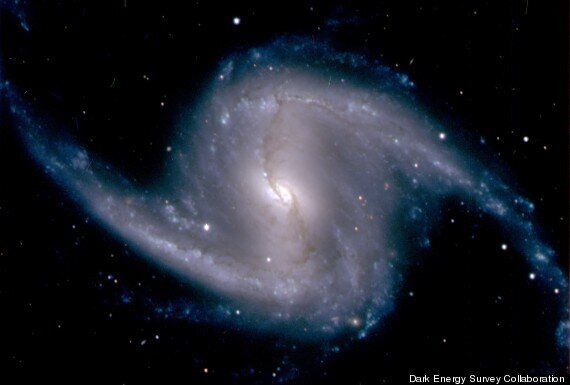It’s taken eight years to build, boasts 570 megapixels and it’s hoped that it’ll help answer one of the greatest mysteries in science – why the expansion of the universe is accelerating.
The Dark Energy Camera has come online on a mountaintop in Chile and produced its first incredible images.
The purpose of the camera, as its name suggests, is to hunt for dark energy.

Zoomed-in image from the Dark Energy Camera of the barred spiral galaxy NGC 1365, in the Fornax cluster of galaxies, which lies about 60 million light years from Earth
No one knows what the nature of that energy is – or even if it exists – but some experts believe that this hypothetical cosmic force is responsible for pushing the universe apart.
The camera, which was built at the US Department of Energy's (DOE) Fermi National Accelerator Laboratory in Batavia, Illinois, can see light from over 100,000 galaxies up to eight billion light years away – and it’s hope that this light will reveal why expansion of the universe is gaining speed.
"The achievement of first light through the Dark Energy Camera begins a significant new era in our exploration of the Cosmic Frontier," said James Siegrist, DOE associate director of science for high-energy physics.

This picture shows the Dark Energy Camera imager - the blue circle, left of centre
"The results of this survey will bring us closer to understanding the mystery of dark energy and what it means for the universe."
The Dark Energy Camera, which is about the size of a phone booth and is mounted on the Victor M Blanco telescope at the National Science Foundation's Cerro Tololo Inter-American Observatory, will also allow scientists from around the world to pursue investigations of asteroids in our own solar system.
But its primary purpose will be to carry out a Dark Energy Survey, the largest galaxy survey ever undertaken, snapping galaxy clusters, supernovae, the large-scale clumping of galaxies and weak gravitational lensing in the hunt for dark energy.
The survey is expected to begin in December, after the camera is fully tested, and will take advantage of the excellent atmospheric conditions in the Chilean Andes to deliver pictures with the sharpest resolution seen in such a wide-field astronomy survey.
In just its first few nights of testing, the camera has already delivered images with excellent and nearly uniform spatial resolution.
Over five years, the survey will create detailed colour images of one-eighth of the sky, or 5,000 square degrees, to discover and measure 300 million galaxies, 100,000 galaxy clusters and 4,000 supernovae.
"The Dark Energy Survey will help us understand why the expansion of the universe is accelerating, rather than slowing due to gravity," said Brenna Flaugher, project manager and scientist at Fermilab. "It is extremely satisfying to see the efforts of all the people involved in this project finally come together."